The plastics industry claims that ‘chemical recycling’ or ‘advanced recycling’ technologies, which use heat or solvents to convert waste plastic into chemical feedstocks that can potentially be further processed into new plastics, are a green alternative to mechanical recycling.But according to a new report, five out of eight U.S. facilities assessed use chemical processes to produce combustible fuel, not new plastics. In addition, facilities are disposing of large amounts of hazardous waste which in some cases includes benzene — a known carcinogen — lead, cadmium and chromium.Critics say the chemical recycling industry’s multi-step incineration processes are polluting and generating greenhouse gases without alleviating virgin plastic demand. Environmental permits for six U.S. facilities allow release of hazardous air pollutants that can cause cancer or birth defects.A new UN framework to fight global plastic pollution could offer nations flexibility over how they meet recycling targets, potentially allowing the industry to lobby for policy incentives and regulatory exemptions for plastic-to-fuel techniques — policies that may threaten the environment and public health, say experts. A host of cutting-edge plastics processing technologies, known collectively as ‘chemical recycling,’ are releasing large quantities of toxic and hazardous substances into the environment. But the majority — while making fuel and chemicals — are producing no recycled plastic, according to a recent report by the Natural Resources Defense Council (NRDC).
With over 240 million metric tons of new plastics generated every year, a growing global mountain of plastic waste now threatens to destabilize Earth’s operating system, potentially closing the habitable window of climate and biogeochemical conditions that human civilizations have relied upon for survival over the past 12,000 years.
The United States is one of the world’s top plastic producers, but less than 9% of what it makes is currently recycled, mostly through the established process of mechanical sorting and shredding. Plastic industry representatives claim that so-called cutting edge ‘chemical recycling’ or ‘advanced recycling’ technologies, which use heat or solvents to convert waste plastic into fuels or chemical feedstocks, are the best recycling solution. But environmental groups, including NRDC, have raised concerns over the greenhouse gas emissions and toxic pollution generated by these processes.
Over 240 million metric tons of new plastics are generated planetwide every year, but only a small fraction is being recycled. Together with other novel chemical pollutants, plastic waste and its impacts threaten to push Earth outside of the habitable zone for humanity. Image by EFRH on VisualHunt.
Chemical recycling creating pollution?
The NRDC investigation collated publicly available data in the summer of 2021 from U.S. Environmental Protection Agency (EPA) databases and state environmental permits for chemical recycling facilities across the United States. They identified eight sites that were either already operating or expected to become operational in the near future.
EPA records revealed that several of these recycling facilities were disposing of large amounts of hazardous waste, containing chemicals such as benzene — a known carcinogen — as well as lead, cadmium and chromium. State-level environmental permits for six facilities allow for the release of hazardous air pollutants, including chemicals that can cause cancer or birth defects.
“The facilities were releasing or permitted to release a variety of hazardous air pollutants,” said NRDC Senior Scientist and report author Veena Singla. “That’s certainly of concern for the communities in direct proximity.” Those communities, the report found, were disproportionally low-income neighborhoods and communities of color. About 380,000 people live within 3 miles of the eight facilities and may be impacted by their toxic emissions.
Judith Enck, president of Beyond Plastics, a not-for-profit project based at Bennington College in Vermont, and a former EPA regional administrator, described NRDC’s investigation as “invaluable,” adding that, “every elected official who’s thinking about supporting [chemical recycling] facilities should read the report first.”
Less than 9% of U.S. plastic waste is recycled, the majority of which is sorted and shredded mechanically before being processed into recycled plastic pellets. Mechanical recycling of plastic has proved difficult to scale-up because of the wide variety of plastic types and sources of contamination present in household and commercial waste, challenges that have also besieged emerging plastic-to-plastic chemical recycling technologies. Image by Tony Webster on Flickr.
Plastics production continues to soar leaving the world with the difficult problem of how to process and reuse waste. Image courtesy of Our World in Data.
However, Plastics Industry Association Vice President of Government Affairs Matt Seaholm, accused the NRDC report of utilizing “cherry-picked examples, incomplete data, and unsubstantiated claims.” He said that “Attacks on advanced recycling technologies tend to follow the same pattern: ignoring the advancements and investments from many different companies, making unrealistic calls to end plastics production, and ignoring industry positions on waste-to-fuel recovery. NRDC’s report is no different.”
Singla invited the industry to provide substantiation for Seaholm’s claims: ”If they are aware of additional data on more facilities, or for these facilities, we’d be very happy to look and do an updated analysis.” She noted that the investigation included all publicly accessible data available at the time of analysis.
The American Chemical Council and the World Plastics Council did not respond to Mongabay’s request for comment.
Plastic-to-fuel conversion: Greenwashing incineration?
Chemical recycling is being marketed as an alternative to mechanical recycling that can meet the growing demand for recycled plastic and reduce the volume of waste being incinerated or ending up in landfills. However, chemical plastic-to-plastic recycling projects have been besieged by problems as they attempt to scale-up from promising laboratory studies into commercially viable enterprises, and five out of eight facilities identified in the NRDC report were instead converting waste plastics into combustible fuel.
“Producing fuel from plastic is not a circular process,” said NRDC’s Singla. Based on the data their investigation obtained, “this is not a solution for a circular, non-toxic materials cycle for plastic.”
Technologies such as pyrolysis and gasification degrade plastics in high-temperature chambers, often in low-oxygen conditions, to produce a liquid or gas that can be further processed into fuel or chemicals. Although the industry claims these processes can be used to generate new plastic, the NRDC report found no evidence that this is happening in practice. And since the low-grade fuels and chemical waste produced are ultimately burned, critics argue these techniques are simply multi-step incineration processes, generating greenhouse gas emissions and hazardous waste without alleviating consumer demand for virgin plastics.
Despite these concerns, pressure is mounting on politicians and policymakers to classify chemical recycling — including plastic-to-fuel processes — as a manufacturing technology and not solid-waste incineration. Sixteen U.S. states have already passed recycling legislation that redefines chemical recycling facilities as manufacturers, exempting them from stricter reporting requirements imposed on solid waste recyclers, and similar bills have been advanced in other states including New York.
“That’s really concerning,” commented Singla. “There’s already a lack of transparency and reclassifying [of chemical recycling facilities] would narrow that further,” she said.
The EPA is currently evaluating how to regulate pyrolysis and gasification technologies under the Clean Air Act, with industry lobbyists fiercely campaigning to prevent these high-temperature degradation techniques from being classed as incineration.
As the demand for oil used for energy decreases, petrochemical companies, like these facilities seen here in Houston, Texas, are ramping up their plastic production which will increase the demand for green plastic waste disposal solutions. Image by Louis Vest via Flickr (CC BY-NC 2.0).
Could chemical recycling hurt global efforts to curb plastic pollution?
Chemical recycling is coming under the global spotlight just as the world comes together to acknowledge and address the plastic crisis. In early March, 175 countries agreed on a UN framework to fight global plastic pollution from cradle-to-grave, reigniting optimism among campaigners. However, environmentalists warn that flexibility in the framework over how individual nations meet recycling targets could leave the door open for exploitation by industry lobbyists seeking policy incentives and regulatory exemptions for plastic-to-fuel techniques.
Some experts say that chemical recycling, and particularly technologies that generate combustible fuel rather than new plastics, are not the plastic-waste solutions the world is so desperately seeking. “I was really disappointed with what we found [in our report], because the plastic waste crisis is so visible and so imminent and I wanted there to be some additional solutions. Unfortunately this isn’t it,” Singla concluded.
Chemical recycling is “a public relations attempt used by the petrochemical industry to try to hold back actual solutions to the growing plastic pollution problem,” said Enck. She encouraged state lawmakers in the U.S. to introduce legislation prohibiting chemical recycling facilities, extending producer responsibility to discourage unnecessary plastic packaging, and incentivizing plastic bottle return programs.
Citation:
Singla (2022) Recycling Lies: “Chemical Recycling” of Plastic Is Just Greenwashing Incineration (Issue Brief).
Banner image: Plastic waste being dumped in Beaver County, Pennsylvania. Plastics production exploded after World War II, and its pollution of water, land and air is now a global crisis. Image by Ted Auch/FracTracker Alliance.
FEEDBACK: Use this form to send a message to the author of this post. If you want to post a public comment, you can do that at the bottom of the page.
Plastics can take hundreds of years to fully decompose. The United Nations met in March to begin developing a cradle-to-grave global plastics production and waste treaty. The plastics industry will likely be lobbying heavily over the next two years for chemical recycling to be included in national action plans. Image by Ivan Radic on Visualhunt.com.
Chemicals, Environment, Environmental Law, Environmental Policy, Global Environmental Crisis, Green, Health, Microplastics, Ocean Crisis, Oceans, Plastic, Pollution, Public Health, Research, Toxicology, United Nations, Waste, Water Pollution
Print






